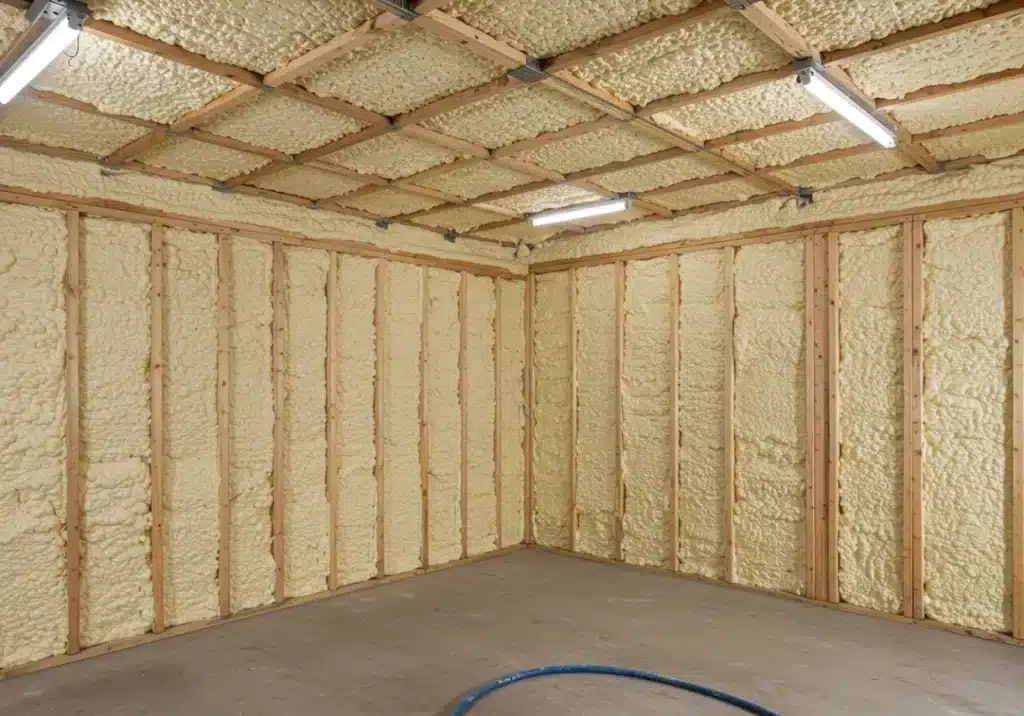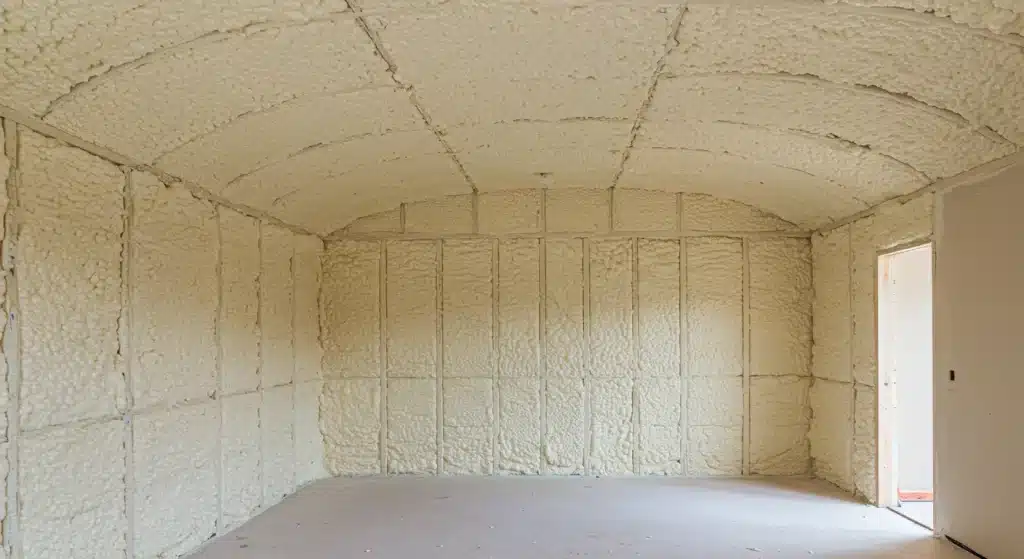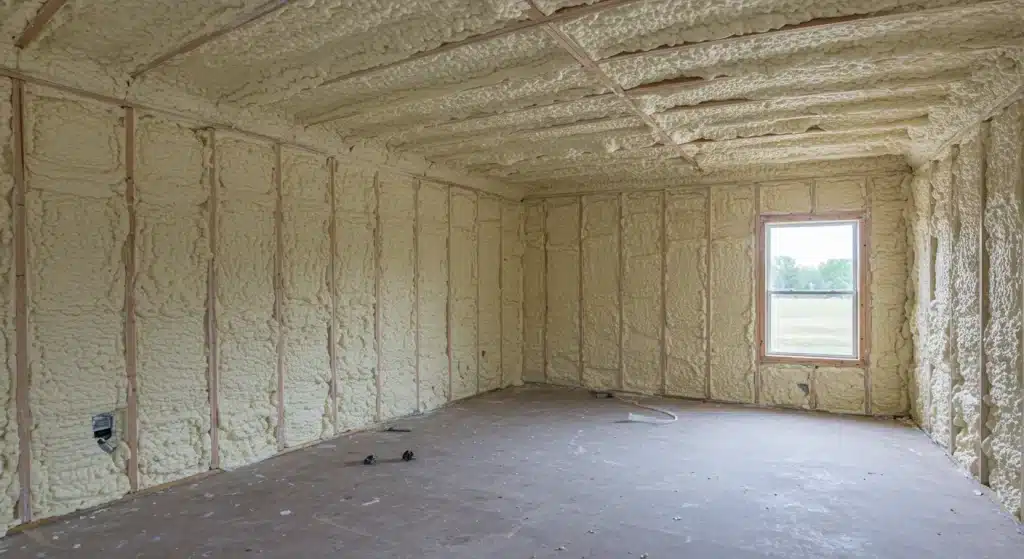Spray foam insulation is highly effective for soundproofing homes because it creates a solid, seamless barrier that seals the gaps and cracks where sound travels. Unlike traditional insulation batts, spray foam expands to fill every void in a wall or ceiling cavity, drastically reducing the transmission of airborne noise like traffic, conversations, and televisions. This air-sealing quality is the primary reason for its acoustic performance, as it eliminates the pathways sound waves use to move through a building’s structure.
This article provides a detailed look at how spray foam works to control noise, the differences between foam types, and practical considerations for Fresno homeowners. The information we’re sharing comes from our team’s extensive field experience and an understanding of building science principles. By understanding how the material functions, you can make a more informed decision about managing noise in your home.
How Spray Foam Manages Sound Transmission
Sound moves through homes in two primary ways: through the air (airborne noise) and through the structure itself (structure-borne or flanking noise). Spray foam insulation tackles both.
Its dense and rigid structure after curing serves as a physical barrier that blocks sound waves from passing directly through walls or ceilings. More importantly, its ability to create a near-perfect air seal stops sound from flanking around studs and joists or leaking through small openings. A report from the U.S. Department of Energy highlights that air leakage can be a major source of energy loss and, by extension, noise infiltration. By stopping the air, you stop a lot of the sound it carries.
There are two main types of spray polyurethane foam (SPF), and each handles sound a bit differently.
- Open-Cell Foam: This type is less dense and has a softer, more flexible texture. The “open” cells in its structure are excellent at absorbing sound waves, a principle detailed by the Insulation Contractors Association of America, trapping them and converting them into a tiny amount of heat. It’s particularly effective at reducing mid-to-high frequency sounds like voices and music within a room.
- Closed-Cell Foam: This foam is dense, rigid, and provides structural reinforcement. Its closed-cell structure is less about absorbing sound and more about blocking it entirely. It acts as a formidable barrier to a wide range of frequencies, making it a good choice for exterior walls to block outside noise.
Comparing Foam Types for Acoustic Control
Choosing between open-cell and closed-cell foam often depends on the specific sound issue you’re trying to solve and your budget. One is not universally better than the other; they just serve different acoustic functions.
| Feature | Open-Cell Spray Foam | Closed-Cell Spray Foam |
|---|---|---|
| Primary Acoustic Function | Sound Absorption | Sound Blocking |
| Density | Low (approx. 0.5 lbs/cubic foot) | High (approx. 2.0 lbs/cubic foot) |
| Structure | Soft, flexible, sponge-like | Hard, rigid, adds structural strength |
| Best For | Interior walls, home theaters, reducing echo | Exterior walls, floors, blocking low-frequency noise |
| Cost | Lower | Higher |
Bonus Tip: For spaces like home theaters or recording studios, using open-cell foam in the interior wall cavities is a great way to improve sound quality and reduce echo. For exterior walls facing a busy Fresno street, the density of closed-cell foam provides a more effective block against traffic noise.
Practical Soundproofing Applications in the Home
Spray foam can be applied to several key areas to significantly reduce unwanted noise.
- Exterior Walls: This is the first line of defense against outside noise from traffic, neighbors, and landscaping crews. Closed-cell foam is often the preferred choice here for its superior blocking ability and added thermal insulation.
- Interior Walls: Applying open-cell foam in the walls between rooms, especially between bedrooms and living areas or laundry rooms, can create a much quieter and more private home environment.
- Floors and Ceilings: Noise from footsteps, dropped items, and general activity on an upper floor can be a major annoyance. Spraying foam in the cavities between floor joists disrupts the path of this structure-borne sound.
- Media Rooms and Home Offices: To isolate sound and prevent it from disturbing the rest of the house, insulating the walls and ceiling of a dedicated media room or office with open-cell foam is highly effective. Data published by the Spray Polyurethane Foam Alliance shows that foam insulation assemblies can achieve high Sound Transmission Class (STC) ratings, which measure how well a partition reduces airborne sound.
Things to Consider Before Making a Decision
Before you decide to use spray foam for soundproofing, it’s important to evaluate a few key factors.
- Project Type: Are you building a new home or retrofitting an existing one? In new construction, applying spray foam is straightforward. In a retrofit, it typically requires removing drywall to access the wall cavities, which adds to the project’s complexity and cost.
- Noise Source: Identify the type of noise you want to reduce. Is it the low rumble of a truck or the high-pitched sounds of conversation? This will help determine whether sound absorption (open-cell) or sound blocking (closed-cell) is the priority.
- Ventilation Needs: Because spray foam, particularly the closed-cell variety, creates an airtight seal, your home’s ventilation must be considered. A professional installer will assess whether mechanical ventilation, like an HRV or ERV, is needed to ensure healthy indoor air quality.
- Installation Quality: Spray foam is not a DIY product. Its effectiveness for both thermal and acoustic insulation depends entirely on a correct installation. The chemical mixture, temperature, and application technique must be precise. Always work with a qualified and experienced contractor.
Bonus Tip: While spray foam is a powerful soundproofing tool, it’s one part of a larger system. For maximum sound isolation, consider it alongside other solutions like solid-core doors, acoustic caulk, and double-pane windows.

Frequently Asked Questions
What STC rating does spray foam have?
Spray foam itself doesn’t have a standalone STC rating; the rating applies to the entire wall or floor assembly. However, walls insulated with spray foam can achieve STC ratings of 50 or higher, which is considered excellent for speech privacy.
Can spray foam reduce noise from plumbing pipes?
Yes. Encapsulating water supply and drain lines with spray foam can dramatically dampen the sound of running water and pipe vibrations. The foam clings directly to the pipes, absorbing the sound at its source.
Will soundproofing with spray foam increase my home’s value?
A quieter home is a more comfortable home, which is a desirable feature for potential buyers. While it may not have a direct dollar-for-dollar return like a kitchen remodel, the added comfort and energy efficiency from spray foam insulation are strong selling points.
How long does the installation take?
For an average-sized home, insulating the exterior walls for soundproofing can typically be completed in one to three days. The foam cures quickly, and other construction work can usually resume shortly after the application is finished.
Final Considerations
Spray foam insulation offers powerful, dual benefits for thermal performance and sound control. To achieve the best results, it’s crucial to match the foam type to your specific sound issue whether blocking external traffic or absorbing interior echo. Factoring in your project scope, budget, and ventilation needs will help you create a comprehensive and effective soundproofing strategy.
Get a Professional Assessment
To apply these considerations and determine the best soundproofing strategy for your home, a professional evaluation is the logical next step. For a detailed consultation tailored to your property’s specific needs, you can reach out to Supreme Spray Foam Fresno. Contact the team by phone at (559) 545-0800 or send an email to [email protected] to discuss your project.
Sources
- U.S. Department of Energy – Provides information on the importance of air sealing for energy efficiency, which is directly related to blocking airborne sound transmission.
- Insulation Contractors Association of America – Explains how different types of insulation, including open-cell foam, control sound through absorption and blocking.
- Spray Polyurethane Foam Alliance (SPFA) – Offers technical documents and data on the performance of spray foam, including its acoustic properties and STC ratings in various assemblies.





